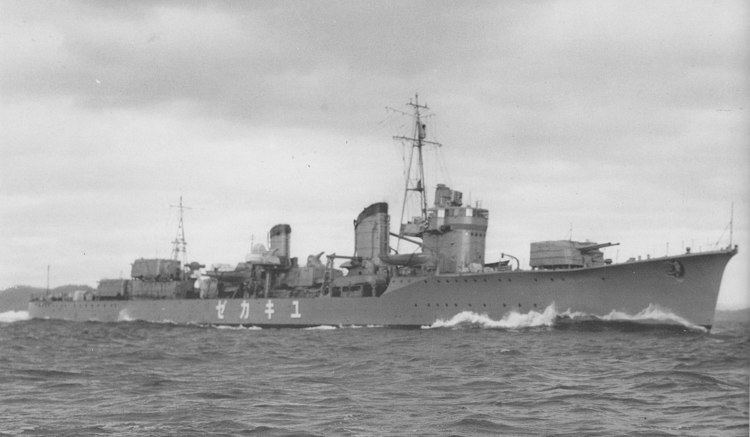Name Kagerō class Planned 18 (1937) + 4 (1939) | Preceded by Asashio class | |
 | ||
Succeeded by Yūgumo classAkizuki class In commission 1939–1947 (Japan),1947–1966 (Republic of China) | ||
The Kagerō-class destroyers (陽炎型駆逐艦,, Kagerō-gata Kuchikukan) were a group of 19 destroyers built for the Imperial Japanese Navy during the 1930s. The IJN called them Destroyer Type-A (甲型駆逐艦,, Kō-gata Kuchikukan) from their plan name.
Design and description
The Kagerō class was an enlarged and improved version of the preceding Asashio class. Their crew numbered 240 officers and enlisted men. The ships measured 118.5 meters (388 ft 9 in) overall, with a beam of 10.8 meters (35 ft 5 in) and a draft of 3.76 meters (12 ft 4 in). They displaced 2,065 metric tons (2,032 long tons) at standard load and 2,529 metric tons (2,489 long tons) at deep load. The ships had two Kampon geared steam turbines, each driving one propeller shaft, using steam provided by three Kampon water-tube boilers. The turbines were rated at a total of 52,000 shaft horsepower (39,000 kW) for a designed speed of 35 knots (65 km/h; 40 mph). The ships had a range of 5,000 nautical miles (9,300 km; 5,800 mi) at a speed of 18 knots (33 km/h; 21 mph).
The main armament of the Kagerō class consisted of six Type 3 127-millimeter (5.0 in) guns in three twin-gun turrets, one superfiring pair aft and one turret forward of the superstructure. They were built with four Type 96 25-millimeter (1.0 in) anti-aircraft guns in two twin-gun mounts, but more of these guns were added over the course of the war. The ships were also armed with eight 610-millimeter (24.0 in) torpedo tubes for the oxygen-fueled Type 93 "Long Lance" torpedo in two quadruple traversing mounts; one reload was carried for each tube. Their anti-submarine weapons comprised 16 depth charges.
At the time of introduction, these destroyers were among the most deadly destroyers afloat, primarily due to the excellent range and lethality of its "Long Lance" torpedo. Only the lack of radar hindered their otherwise superb design. As with most pre-World War II ships, Kagerōs were also deficient in anti-submarine and anti-aircraft weaponry as designed. Over the course of the war these deficiencies were remedied, with depth charge capacity increased to 36 and the addition of four depth charge launchers; anti-aircraft weaponry also increased steadily from four 25 mm guns at the start of the war to twenty-eight mounts by the war's end, which necessitated the removal of the upper rear turret.
Wartime attrition was hard on the Kagerōs, with 18 of 19 ships lost. In all, six were sunk by air attack, five by submarine attack, five in battle with other surface forces, one by a mine, and the remaining two sunk by a combination of mines and air attack. Yukikaze was the only Kagerō-class ship afloat at the end of the war.
